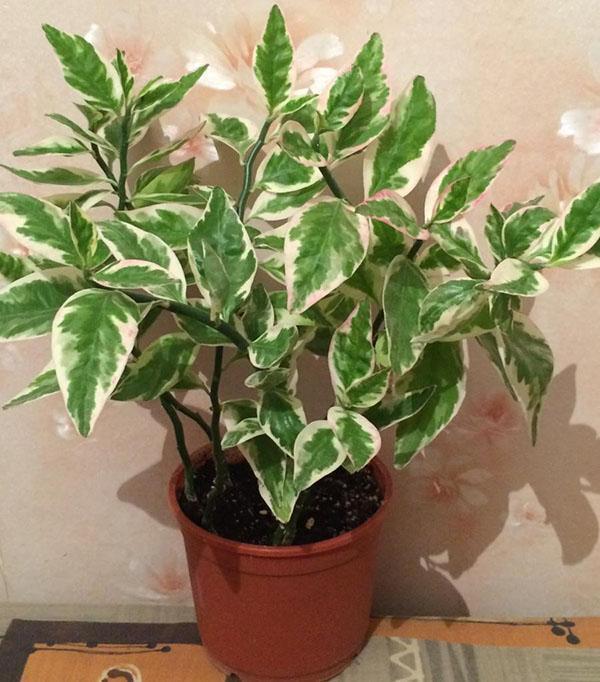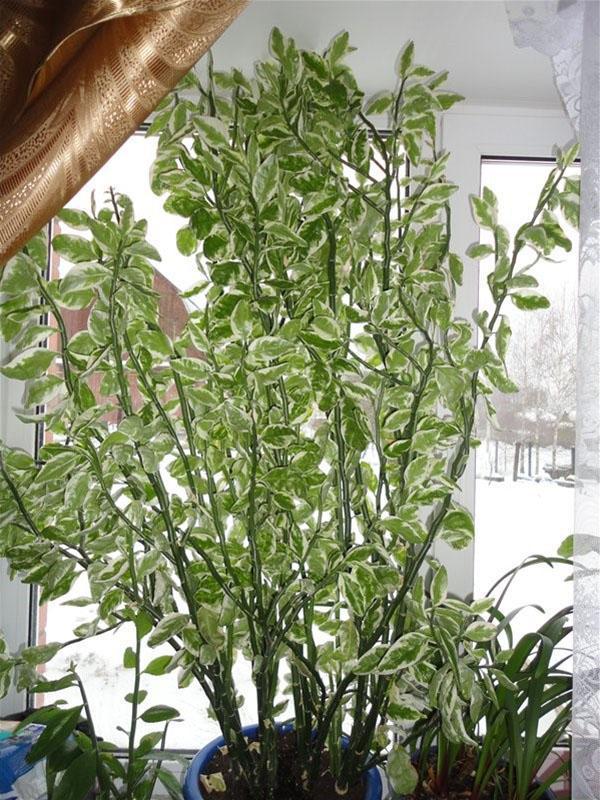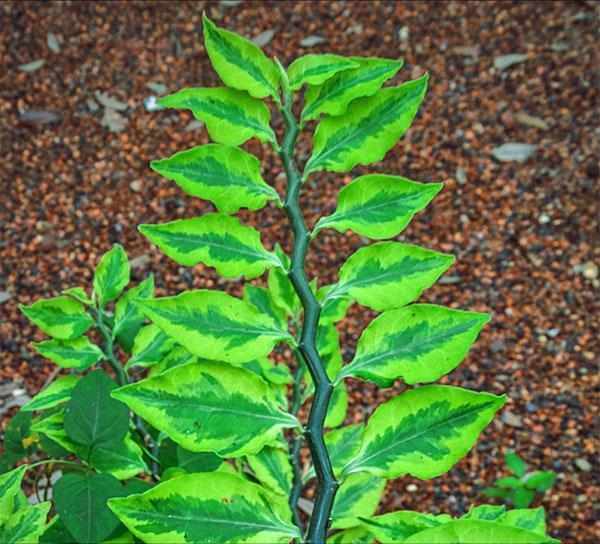Everything you need to know about transplanting, reproducing and pruning pedilanthus
 When pedilanthus appears in the collection on the windowsill, transplanting, pruning and propagating a flower become important stages of care. This will allow you to enjoy lush greenery and active growth of an amazing flower for many years.
When pedilanthus appears in the collection on the windowsill, transplanting, pruning and propagating a flower become important stages of care. This will allow you to enjoy lush greenery and active growth of an amazing flower for many years.
Pedilanthus came to the number of indoor plants from the dry subtropics of Central and South America. Powerful stems and leathery leaves give out in this culture a plant accustomed to withstand the sun's rays and lack of moisture. On the rocky plains where pedilanthus grows, the soil is not rich in nutrients, and its layer is not too large. Such conditions are close to those in which succulents live. However, unlike cacti, pedilanthus grows rather quickly and in nature can reach a height of 2.4 meters. This predetermines the particular care that the plant should receive at home.
Without limiting the vertical growth, the pedilanthus also tends upward in the room, but the stems very reluctantly branch out and gradually become bare from below.

Pruning pedilanthus
 Like many indoor plants, the pedilanthus has a period of relative dormancy, during which its development is inhibited. From spring to mid-autumn, the flower grows actively. Shoots grow, new foliage appears. In February and early March, shortly before this, the grower should think about pruning the pedilanthus. If it's done on time:
Like many indoor plants, the pedilanthus has a period of relative dormancy, during which its development is inhibited. From spring to mid-autumn, the flower grows actively. Shoots grow, new foliage appears. In February and early March, shortly before this, the grower should think about pruning the pedilanthus. If it's done on time:
- succulent flower stems do not lose much moisture;
- the places of the cuts dry out quickly;
- over the summer, the plant is restored;
- removing the tops of the shoots triggers their branching, increasing the decorative effect of the flower.
Pedilanthus is not afraid of deep pruning, so it is equally possible to pinch the very tips of the stems and shorten adult perennial shoots. In the latter case, several dormant buds are left above the ground level for their renewal.
Trimming pedilanthus is carried out with a sharp knife along the internode. Since the plant contains milky sap, which can hinder healing, the sections are slightly dried and treated with crushed activated carbon. Before starting the formation of the pedilanthus bush, watering the flower is reduced and resumed in the same volume only after a few days.
The green parts of the plant left after pruning and transplanting pedilanthus become excellent planting material when propagated.
Reproduction of pedilanthus at home
 In nature, pedilanthus propagates by seeds and vegetatively, with the help of rooting of growing and lodging stems. Egg-shaped seeds up to 8 mm long are formed after pollination of red or orange-pink flowers of a bizarre shape. When they ripen, the capsule bursts, scattering the contents over the surrounding area.
In nature, pedilanthus propagates by seeds and vegetatively, with the help of rooting of growing and lodging stems. Egg-shaped seeds up to 8 mm long are formed after pollination of red or orange-pink flowers of a bizarre shape. When they ripen, the capsule bursts, scattering the contents over the surrounding area.
At home, reproduction of pedilanthus by seeds is almost not practiced due to their toxicity, the complexity of pollination of flowers and the duration of the germination process.
The most common method of flower propagation is by rooting cuttings, which can be obtained from the middle and apical portions of the stem. You can cut a flower throughout the warm season, but it is preferable to use spring pruning. In this case, the cuttings have time to take root and grow before the onset of autumn.
The optimal length of cuttings for propagation of pedilanthus is 8–10 cm or 3-4 internodes:
- The lower leaves on the planting material are removed.
- The cuttings are washed in warm water to remove the protruding milky juice, and then dried with a soft cloth.
- To reduce the risk of decay of the cuttings, the cuttings are left to dry for another 18-24 hours.
 For rooting, use soft, settled water at room temperature, light soil mixture, sand or vermiculite. Cuttings for propagation of pedilanthus, after being placed in the ground, are transferred to a greenhouse, where the plants will have to stay for 2 to 4 weeks at a temperature of 20–25 ° C. Watering the planting should be moderate to prevent rotting of the underground part. For cuttings, condensation is also harmful, which forms when there is a lack of fresh air and an abundance of moisture.
For rooting, use soft, settled water at room temperature, light soil mixture, sand or vermiculite. Cuttings for propagation of pedilanthus, after being placed in the ground, are transferred to a greenhouse, where the plants will have to stay for 2 to 4 weeks at a temperature of 20–25 ° C. Watering the planting should be moderate to prevent rotting of the underground part. For cuttings, condensation is also harmful, which forms when there is a lack of fresh air and an abundance of moisture.
If the stem is still rotted, do not despair. After trimming the affected area and drying, the pedilanthus stalk can again be used to propagate a houseplant.
Pedilanthus transplant
 Spring is the best time not only for pruning and reproduction, but also for transplanting pedilanthus. The plant should be transferred to a new pot only after the root system has occupied the entire volume of the previous one. The roots of this culture are not too large, so you will not have to transplant the flower very often.
Spring is the best time not only for pruning and reproduction, but also for transplanting pedilanthus. The plant should be transferred to a new pot only after the root system has occupied the entire volume of the previous one. The roots of this culture are not too large, so you will not have to transplant the flower very often.
The pot should be only 1–2 cm wider than before, and its depth should be equal to the diameter. Pedilanthus does not have any special requirements for the substrate. Ready-made mixtures are best suited for decorative leafy crops or violets.
At the bottom of the container, a powerful drainage layer is arranged, which excludes stagnation of moisture and acidification of the soil that is dangerous for the plant.
Before transplanting pedilanthus, the substrate, especially if it is made independently from a mixture of garden and sod soil, peat and sand, should be disinfected. This will prevent pests, pathogenic bacteria and fungi from infesting the plant.
 Although the flower cannot be called "sissy", there are pedilanthus pests and diseases that can harm the plant. Violation of humidity and temperature conditions can cause rot of bacterial and fungal origin. If a flower falls on the balcony in the summer or is kept in a summer cottage, the stems and leaves attack the scale insects and aphid... But most often, among the enemies of pedilanthus, they call mealybug and spider mites.
Although the flower cannot be called "sissy", there are pedilanthus pests and diseases that can harm the plant. Violation of humidity and temperature conditions can cause rot of bacterial and fungal origin. If a flower falls on the balcony in the summer or is kept in a summer cottage, the stems and leaves attack the scale insects and aphid... But most often, among the enemies of pedilanthus, they call mealybug and spider mites.
Since the stems, leaves and even seeds of the plant contain substances that are toxic to humans, strict precautions are required when transplanting, reproducing and pruning pedilanthus.
Even a few drops of juice from the root or shoot of a pedilanthus is enough to irritate the mucous membranes. The ingress of toxic compounds on the lining of the stomach and intestines causes nausea and vomiting. The effect of the juice on sensitive skin is to irritate the integument, inflammation, and sometimes the appearance of chemical burns and blisters. The liquid acts especially sharply on the eyes. The organs of vision experience severe pain, suffer from conjunctivitis and lacrimation. Swallowing multiple seeds can result in severe, persistent vomiting and diarrhea.
When working with a flower, especially when pruning a pedilanthus and transplanting it, you need to use gloves. If the juice gets on the skin or eyes, it is necessary to immediately remove traces of it with warm running water.